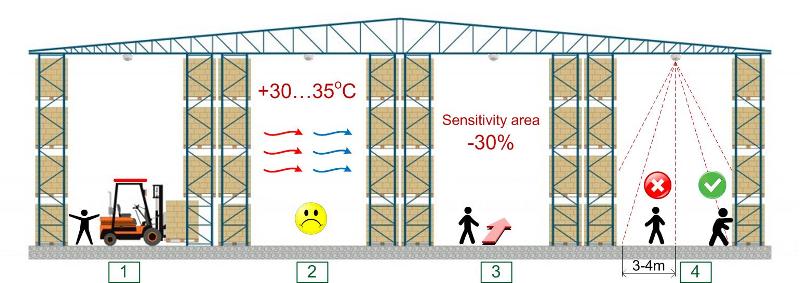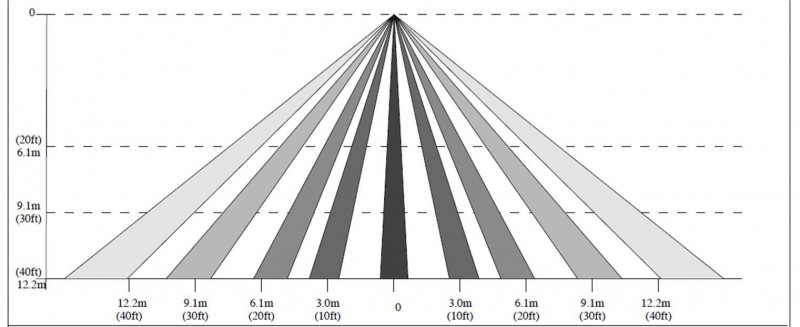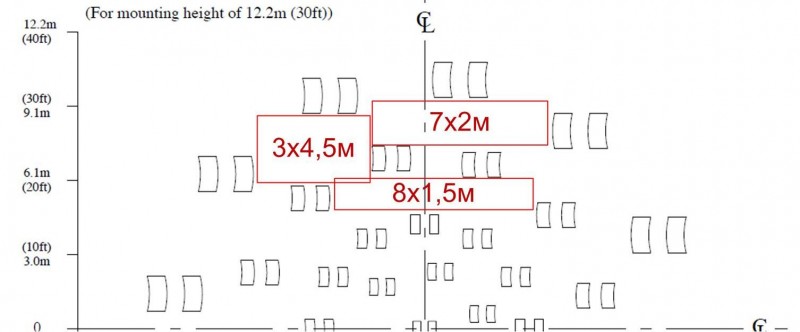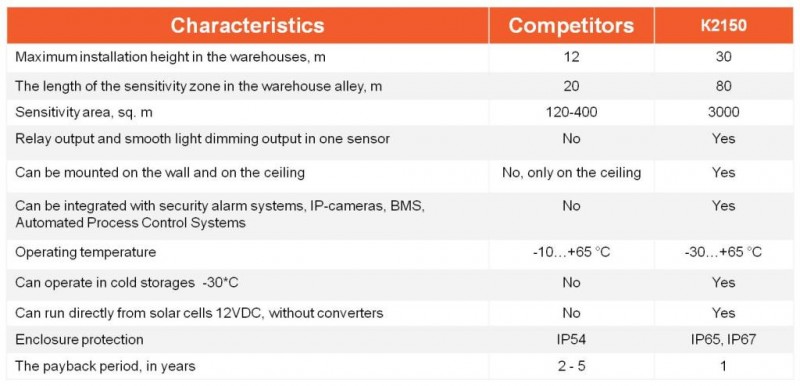K2150 vs PIR
The main competitors of our sensors at the moment are ceiling-mounted passive infrared motion sensors (PIR-sensors) with the installation height of up to 12m and the sensitivity zone length of 20–30m. PIR-sensors are optical beam sensors. They focus radiation of human body heat on a sensitive feather element through special microlenses on a common Fresnel lens.
Some of the disadvantages inherent in PIR-sensors can make your lighting system automation costs inefficient and sometimes even useless. And you should be aware of them.

One of the main disadvantages of infrared motion detectors lies in the physics of the infrared motion detection process itself: they do not react to the motion itself as such, but to the temperature difference between the moving object and the environment. Therefore, for example, if a truck has cooled down to the ambient temperature or it is electric and almost always cold, and the driver’s cabin is covered with Plexiglas, or the driver is wearing warm overalls, infrared motion detectors often do not notice such movement.
2. The second disadvantage is directly related to the first. If your warehouse is located in the southern regions of the country or in countries with a warm/hot climate, then in hot weather, when the air inside the warehouse is heated up to 30 °C and above, the sensors stop to detect movement, as there is no necessary difference in temperature between the background and the person to clearly detect movement, especially at some distance from the sensor. Thus, by installing PIR-sensors in a warehouse in a warm climate, you should be prepared that at least in the summer months they will not function and the lighting will be switched on continuously during this period!
When installing infrared sensors, you should also keep in mind that they will always give false alarms if there are warm or cold air flows from the air conditioning systems in their area.
Our K2150 sensor does not have these disadvantages, because it uses another principle of motion detection: radio signal reflection from a moving object, so the sensor does not care about object’s temperature and ambient temperature.
3. Infrared sensors detect people well when they move across the rays, and the sensors do not “like”, i.e., poorly capture the movement of a person in the direction towards the sensor and away from it. But that’s how a person moves in a warehouse aisle! In this case, you can safely reduce the size of the sensitivity zone specified in the PIR-sensor advertising or certificate, by 30%. Some conscientious manufacturers of PIR-sensors indicate this in the certificates for their products.
4. PIR-sensors also feature, when installed at high levels, recording movement only at certain points of their chart and the distance between these points can reach several meters. Here is an example from the passport data of a lens for high-altitude installation performed by a well-known company from the U.S.: Fig 2. Dead zones of PIR-sensor lenses (marked in red)
How do installers usually solve this problem? They increase the switching delay up to 5–10 minutes or more. This allows the warehouse staff to avoid problems and put the automation system into operation normally.
And how profitable is such automation for a customer? Imagine that there is no one in the aisle by now, and the lighting is on for another 10 minutes, and when it should be finally turned off another truck enters the aisle, and the cycle is repeated. If such traffic is normal for a day, the lighting in this aisle will never turn off! That is, the customer has spent money on automation in vain. And we are aware of such cases.
Fig 3. Usual setting of switch delay time for a PIR-sensor and for a K2150 sensor
The K2150 sensor is devoid of these shortcomings. It has a very high sensitivity. For example, it captures a human palm movement from a distance of 50m with an amplitude of just 15 cm. Therefore, it usually has a switch delay of 30–60 seconds and you obtain the most economical lighting system.
Fig 4. How motion sensor К2150 is different from its competitors







